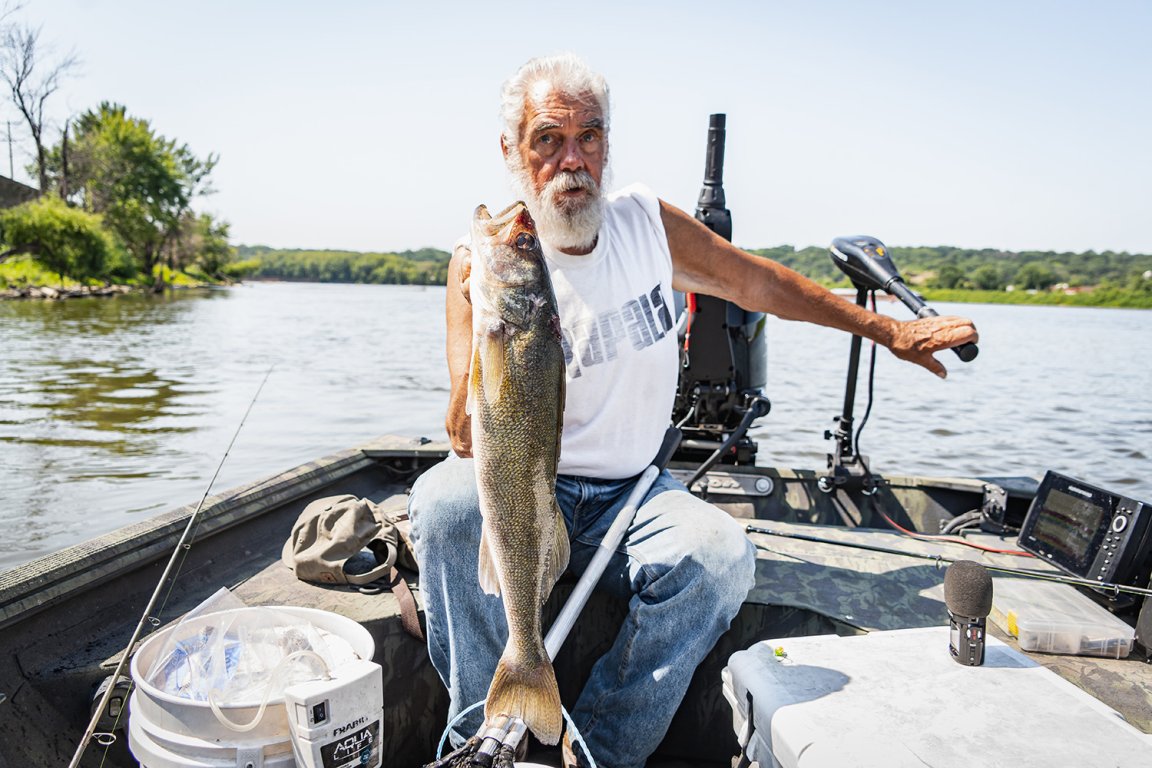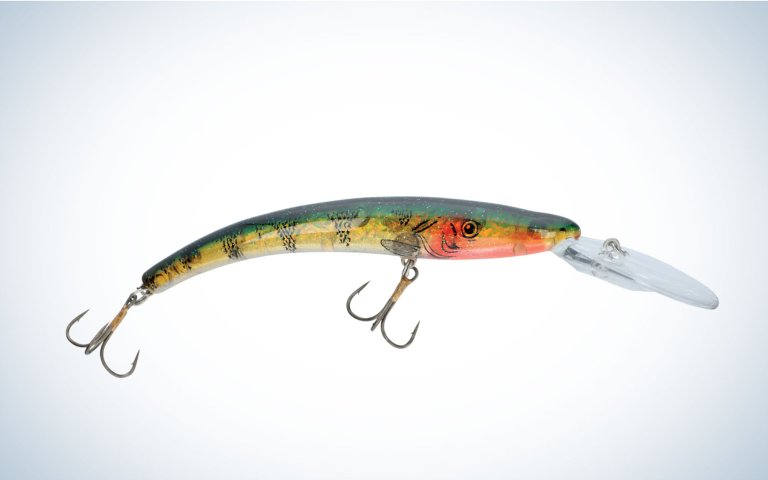Walleye fishing can quickly get complicated and technical. This is mostly because walleyes tend to hang in deeper water, sometimes away from obvious shoreline structure. Most of the time you need a boat, reliable electronics, and a solid understanding of walleye behavior to even locate them.
But the challenges of walleye fishing are well worth taking on. Because when you do get into a school of feeding walleyes, the action can be fast and furious. Plus, walleyes are the best eating freshwater fish on the planet (at least in the opinion of this Minnesotan).
To help you put more walleyes in the livewell I’ve compiled the tips, tactics, and gear from a bunch of Outdoor Life experts, digging deep into our archives. I’ve also caught my share of walleyes over the years and will share some of the things I’ve learned on the water.
While this is a guide for beginners, covering the very basics of walleye fishing, there’s also some expert knowledge tucked into this overview, so anglers of all experience levels can get something out of it.
Quick Walleye Fishing Tips

- Understanding walleye behavior is key to finding these fish in the massive lakes and rivers they love. As a broad generalization, walleyes will hang out in shallower water (think sandy flats and near rocky shorelines) in spring. Then they migrate to mid-lake structures in the summer (think sunken islands and off-shore drop-offs). In the late summer and fall they come back near shore (think deep rocky points, deep weedlines, and sometimes even shallower weedlines).
- In the early spring, walleyes will likely be found in warmer water (relative to the rest of the lake) and in summer they’ll be found in relatively cooler water.
- Walleye fishing can be tough during the dog days of summer. The easiest bites are usually in spring, early summer, and fall.
- Walleye anglers love a good breeze and cloud cover. Because walleyes tend to be low-light feeders, these conditions usually contribute to more consistent feeding.
- It’s important to release the biggest walleyes. Big walleyes of 20 inches or longer tend to be more effective breeders and more important for a waterbody’s walleye population overall. So, throw the giant old fish back. The best tasting fish are smaller anyway. Depending on local regulations (many lakes have walleye slot sizes), 15- to 19-inch fish are perfect keepers.
- Load up on live bait. While there are tons of great walleye lures out there (and we’ll get into the details of many of them later in the story), leeches, nightcrawlers, and minnows are key when it comes to putting walleyes in the boat consistently. These live baits can be fished with jigs, spinner harnesses, or slip bobbers.
- Don’t horse big walleyes up to the boat like you might fight a bass. Because you’ll often target walleyes with lighter tackle, you want to play them more conservatively, while still keeping consistent pressure.
- Don’t be afraid to fish aggressively. While a lot of walleye fishing relies on finesse tactics, remember that walleyes are still predators. They will smash fast-moving crankbaits and rip jigs when they’re in the right mood. Fishing faster will help you cover more water and find more fish.
- Learn to use electronics. Standard fish finders will help you locate good bottom structure and ideal water temperatures. If you’re willing to step up in price, forward-facing sonar will help you find off-shore, roaming fish that were previously nearly impossible to target (watch this video to see how that’s done).

Walleye Gear Tips
Think Light Tackle and Line
Most walleye fishing is done with a spinning rod and spinning reel. A rod that is anywhere around 6 feet 8 inches to 7 feet in length and has a medium or medium-light power and fast action is a good all-around choice. Reel sizes in the 2000 to 3000 range are ideal. Generally speaking, you’ll want to run lighter line for finesse tactics, think 4- to 8-pound test and relatively heavier line for more aggressive presentations, think 10- to 20-pound test. Lighter line makes it easier to detect subtle bites and also cast light lures.
Don’t Overlook Braid
A lot of walleye anglers like braided line because it’s so stiff and responsive. But the key to using for walleyes braid is to add a couple feet of fluorocarbon leader to the end. This leader will be invisible to fish, even in clear water. You can tie your braid to your leader with the excellent FG Knot, the Alberto knot, or the double uni knot.
Slip Bobbers Make It Easy
The good old slip bobber is an easy and effective way to catch walleyes in shallow and medium depths. Slip bobbering, or corking, is effective because it hangs live bait right in front of a walleye’s face. This tactic is super effective at night when paired with a lighted bobber.
But you can also take this simple tactic and get more technical with it by pairing it with side imaging or forward facing sonar.

Boat Control Is Key
Whether you’re drifting, casting, trolling, or vertical jigging, the position of your boat and the speed at which it’s moving are critical to catching fish. This is especially true for drifting and trolling, but the thing is, you’re probably not going to know exactly what speed the fish will like right away. So pay close attention to the finer details and change up speeds if you’re not getting bites. When you do start getting hit, stay consistent with that speed.
Have a Net Ready
Walleyes are not known to be ferocious fighters like smallmouth bass or muskies. But they will spit your lure with a good headshake, and they’ll usually do this right at the boat. So when you do work a nice walleye up, don’t mess around with him boatside. Get him in the net with one smooth, calculated scoop. Wait till the fish is nearly to the surface and within reach and net him headfirst. Rubber nets are best.
Troll Easy
There’s a ton of trolling-specific gear out there. But if you’re just getting started, you don’t need to throw down for trolling rods and planar boards. Simply run a heavier rod and a deep diving crankbait behind the boat to troll deep weedlines and breaks. Many folks don’t love trolling because it can be a bit boring. But if you find that trolling fits your fishing style, then you can dive into the specific gear required to troll like a pro.
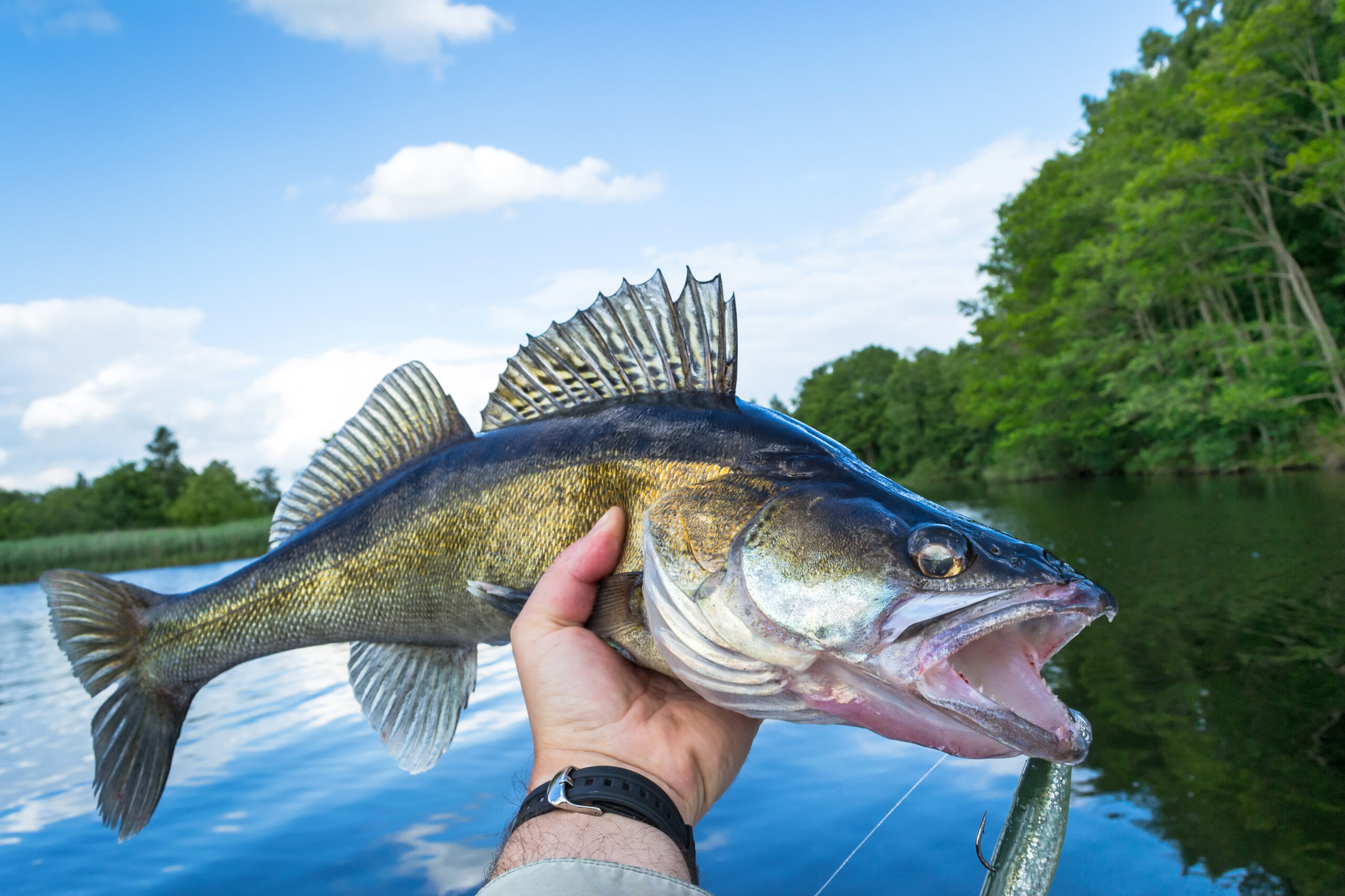
Walleye Fishing Lure Tips
Learn to Love Jigging
Jigging is a walleye fishing staple. It’s a good idea to stock up on a handful of jigs ranging from ⅛ ounces up to ⅜ ounces. The ¼ ounce jig is a go-to for general walleye fishing. Jigs can be tipped with any variety of soft plastics or live bait like minnows, leeches, or night crawlers. You want your jig to bounce off bottom structure with near constant movement. Generally, lighter jigs are used in shallower water and heavy jigs in deep water.
However, one tip I learned from Dick Grzywinski — known as “the Griz” and considered a walleye fishing legend in the Upper Midwest — is that heavy jigs are useful for feeling the bottom when fishing rivers. When I fished the Mississippi with Griz, we used ⅜ ounce jigs even though we were targeting walleyes in only 8 to 12 feet of water.
“Any client can feel the bottom with a heavy jig like that,” Griz says.
Cover More Water with Jigging Raps
A more aggressive jigging tactic is to throw a jigging rap. You cast this lure out and then rip it back with aggressive swings of the rod. The lure darts and flutters like a wounded baitfish and generates reaction strikes from walleyes. The tactic allows you to cover open water much faster than you would be able to with a jig and live bait presentation.

Utilize Trailer Hooks
If you’re running large minnows or night crawlers, adding a trailer hook to your jig or spinner rig can help turn more bites into hookups. Simply embed one of the hooks from the trailer into the tail of your live bait and then even nips can turn into landed fish.
Get Specific with Crankbaits
Pro fisherman Ross Robertson’s favorite all-around walleye crankbait is the Reef Runner, which can be trolled or cast.
“Many walleye anglers are surprised that the Reef Runner can be slow trolled at .8 mph during the cool water periods or effectively fished at speeds nearing 3 mph in the summer. It is one of the few lures that just always seems to work,” Robertson writes in his review of best walleye lures. “The curved body and lip design cause the bait to hunt, creating a built in bite triggering action that catches fish. However, this does come at a price, and the Reef Runner tune needs to be checked frequently. While the original 800 is the most popular, you can also buy a smaller 3 ½ inch version. Both sizes also are offered in a shallow model for casting or when less depth is needed.”
Run a Lindy Rig Like a Pro
A go-to tactic for catching summer walleyes is to drag a live bait rig or crawler harness tipped with live bait. Rigs like the Lindy Rig have put innumerable walleyes in the boat. Here’s Nick Linder on everything you need to know about Lindy rigging.

Downsize During a Mayfly Hatch
One of the toughest times to catch walleyes is during a significant mayfly hatch. To increase your odds here, use what guides call a mayfly rig—a small spinner with a portion of a night crawler on a small hook. Cast the rig out and count it down, then retrieve it slowly, experimenting with depth until you find the strike zone. Walleyes often hit mayflies as they’re on their way to the surface to emerge. Keep the rig small; mayfly larvae are rarely longer than an inch. —Bob Gwizdz
Consider Presentation Over Lure and Jig Color
Many anglers obsess over lure color. While choosing the right lure or jig color can help with success in certain situations, there are a lot more important factors to consider. According to the Griz, how your bait is being presented (speed, action, angle) and its position in the water column are critical points. So if your buddy is catching walleyes but you’re not, try to figure out what he’s doing differently with his presentation rather than simply blaming it on a different color jig.
Turn Up the Volume in Dirty Water
Adding rattles to jigs or using crankbaits with sound chambers increases the odds the fish will zero in on the lure when fishing dirty water. So will increasing its size: If you fish with spinner rigs or crawler harnesses, use larger spinners. Hammered metallic blades work well if it’s sunny; otherwise, use brightly colored blades. If you fish with jigs and bait trailers, a plastic curlytail grub body will add bulk. Bright colors, either fluorescent or multi-hued, are an added attraction, as are glow-in-the-dark jigheads. Scent (either scent-impregnated baits or a spray-on product) is helpful. —Bob Gwizdz
Crank the Weeds
When fishing around weeds, shad-imitating crankbaits, like the Shad Rap or Flicker Shad, are deadly on shallow walleyes, particularly in low light or heavy wind. Add numerous twitches with your rod tip on every cast or trolling pass and your buddies will wonder why you’re catching the most fish. Smaller baits, like the size 5, are best in shallow areas, but deeper-running 6s and 7s are better on the outer edges of the weeds. —Steve Pennaz
Tactical Walleye Fishing Tips
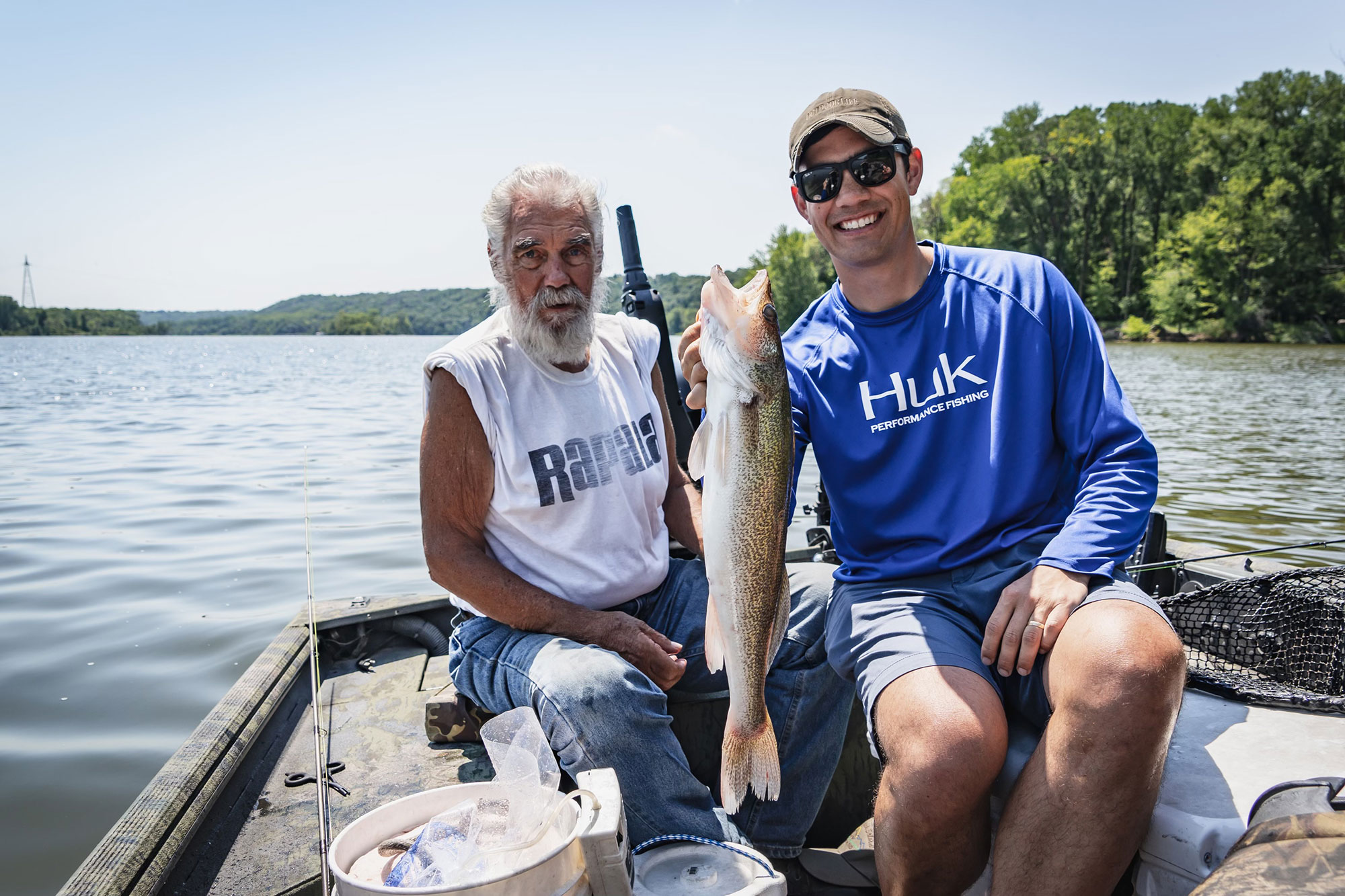
Target Walleyes in the Weeds
Classic walleye structure is so easy to find with today’s insanely good GPS mapping units that top-producing areas in most lakes get fished daily. Walleyes respond to this pressure by moving off the structure to secondary areas, where fewer anglers target them.
A percentage of the walleye population in a given lake may never move to mid-lake structure, particularly if the lake offers good weed growth.
These fish are typically shallow and generally relate to weeds. In stained lakes with poor visibility, look in 4 to 8 feet of water, even in mid-summer. In clearer lakes, the prime depth zone in June is 8 to 12 feet. Weed flats, particularly those close to spawning areas, are best early in the season. Fish in these areas are spooky, so use your trolling motor to move in or you’ll blow walleyes out. Expect walleyes to be scattered across the flat but grouped in small wolf packs of four to eight fish. The key is using baits that allow you to cover water fast–and that means artificials. These areas are nearly impossible to fish with traditional walleye presentations like the live-bait rig. Light jigs–1/32-, 1/16-, and ¼-ounce–are tough to beat, particularly when tipped with a small swimbait or a 2- to 3-inch swimming grub, like the original Power Grub from Berkley. —Steve Pennaz
Hit River Mouths and Shallow Reefs at Night

When walleyes move to river mouths in fall, nighttime is the right time to cash in. In this scenario, it’s tough to beat a long, thin stickbait, largely due to its versatility. These baits can be fished close to the surface or down to approximately 8 feet, and you can cast them or troll them. Target the edges of deep holes or eddies where baitfish can rest out of the current. If there is a pier or breakwall with lights shining in the water close by, that’s often the jackpot because light naturally attracts baitfish. I’ll start by casting a stickbait behind the boat on a spinning rod and then slow-troll it with the electric motor. Every once in a while, I’ll cut the motor to let the lure pause, or snap the rod to make it dart forward. This is a great way to locate a concentration of feeding walleyes, and once I do, I’ll stop the boat and fan-cast.
On smaller bodies of water that don’t feature any bays or river mouths, walleyes typically migrate to shallow reefs come fall. This presents an ideal scenario for casting lipless crankbaits. Much like when you’re bass fishing, cast the lure and work it back from deep to shallow until you pinpoint the holding depth of the walleyes. Once I start getting bites, I reposition the boat so I can cast parallel to the reef, which allows me to keep the lure in that key depth range from the beginning of the retrieve to the end. If you find the fish holding on the deep edges, letting the lure sink and then working it back in a series of sharp rod pumps can be very effective. Occasionally pausing after snaps causes the lure to flutter down like a wounded baitfish, and that’s often when a fish will strike. Fall reef fish have a habit of being spooky, even at night, making a silent shallow-water anchor a major advantage. —Ross Robertson
Troll Rivers
Vertical jigging is probably the most productive technique for walleye fishing in rivers, but high winds or rains that dirty the water can put the fish off the jig bite. When water conditions change for the worse, try trolling near bottom. Use a three-way swivel and tie a sinker on a 6- to 12-inch dropper, or use a bottom-bouncing rig and trail a floating/diving minnow. Troll upstream and cross-current. Don’t be afraid to use a sinker of up to 4 ounces on deep, fast-flowing rivers. —Bob Gwizdz
Be Versatile
The rule of thumb for walleye fishing is to use minnows in cold water and nightcrawlers, leeches or soft-plastics as the water warms. But Mark Martin, a top veteran pro, says you’re making a mistake if you don’t take all types of live bait with you. Although leeches and crawlers may be hard to find in the winter, they’ll sometimes outproduce minnows in cold water, especially if it’s dirty. Other times, even in the heat of the summer, fish want minnows more than other offerings. —Bob Gwizdz
Don’t Get Stuck on the Bottom
Walleye fishermen usually concentrate on the bottom, but often the most active fish are suspended in the water column. When trolling, vary the depth of your offerings by changing your diving bait or adding weight to your lines if trolling with spinner rigs. Sometimes the ‘eyes are out on the prowl, foraging on minnows or shad that are schooled somewhere between the top and bottom. Watch your depth finder for clues to their whereabouts and fish accordingly. —Bob Gwizdz
Go Deep After a Weather Front
One of the toughest bites walleye anglers face is immediately after a weather front passes. With a high, clear sky, the fish often sulk in the depths. The key is to concentrate on deepwater structure and fish with live bait, either slowly trolling or drifting around humps and breaklines, usually right where the bottom begins to flatten out. —Bob Gwizdz
Catch Nighttime Walleyes from Shore
Catching big walleyes from shore can be a serious challenge in summer, but on fall nights, the boatless angler has a serious upper hand. Piers, break walls, and marinas often have just enough lighting and provide just enough of a current break to draw in loads of baitfish. Rest assured, the heavy ’eyes will be there too. Many of these areas are so shallow that a boat couldn’t get in close enough if you wanted it to — or at least not without spooking the fish. To increase your odds of hitting a foot-patrol trophy, don’t be afraid to throw on some chest waders. Getting in the water allows you to fish productive areas the guys on shore can’t reach, or to present lures at angles they can’t match. Use an 8-foot spinning rod to extend your casts and walk softly. Be stealthy with your movements until you get in range of the fish. —Ross Robertson
Hit the Big Basin
Structure is great, but there is also a pretty good “basin bite” in a surprising number of walleye lakes, usually those with lots of deep, clear water and not much in the way of drop-offs, rock piles and the like. In such lakes, tullibees are often abundant and walleyes relish them. But tullibees are cold-water roamers, so walleyes will pursue them in open water.
The technique that seems to work best is trolling Rapala Shad Raps or other thin, deep-bodied crankbaits at a depth of 20 to 30 feet over much deeper water. When the basin bite is on, every other tactic is usually a waste of time. If you are armed with forward-facing sonar, you can find and target fish out in these basins much faster. —Dick Sternberg
Find Transitional Bottom
If you’re fishing a lake with lots of soft bottom, then a good rock pile will likely hold walleyes. Even in a sandy lake, a rock pile will usually produce abundant fish. On the flip side, in a deep, rocky “shield” lake in northwestern Ontario, rocky bottom usually doesn’t mean much (because the entire lake is rocky).
One midsummer day I started out fishing some rocky midlake humps where I presumed the fish would be. After casting jigs and crankbaits onto the top of the humps and dragging bait rigs around the edges, I realized I was wasting my time. Motoring down the shore, I noticed something different: a sandy beach with bulrushes growing right next to shore. A closer look revealed some scattered cabbage in deeper water, so I tossed out a curlytail jig and retrieved it along the outer weed edge. That did the trick. For the next two hours, I got bit on almost every cast — nothing huge, but I caught plenty of fish in the 2- to 4-pound class.
When fishing a rocky shield lake now, I make it a point to look for any kind of sandy structure, whether it’s a sandy shoal, point or hump or just a shallow sandy bay. Walleyes are drawn by the baitfish that take cover in the few weed beds that exist on sandy bottom. A bare rocky bottom usually offers little in the way of food for walleyes. —Dick Sternberg
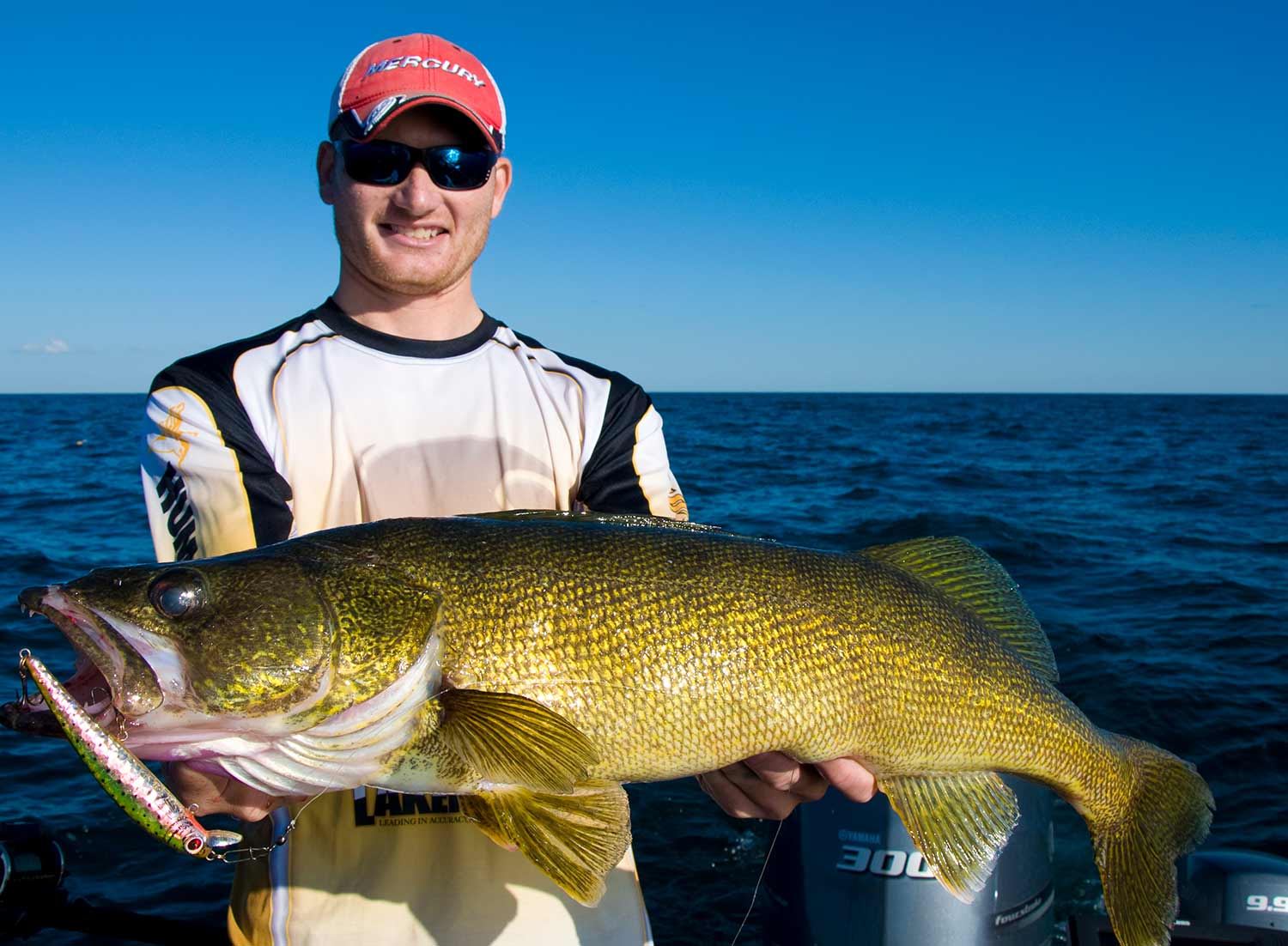
Final Thoughts on Walleye Fishing
The beauty of walleye fishing is that you can you can target them with whichever tactic fits your style. You can cast crankbaits, float live bait, jig, troll, and fish day or night. The best walleye anglers are well versed in all of these tactics and match them to the conditions and time of season. But as you’re just getting into the game, it makes sense to zero in on one or two of these approaches that make sense on your home water and then start refining your skills. You’ll learn the most about walleye fishing by spending time (and lots of it) on the water.
